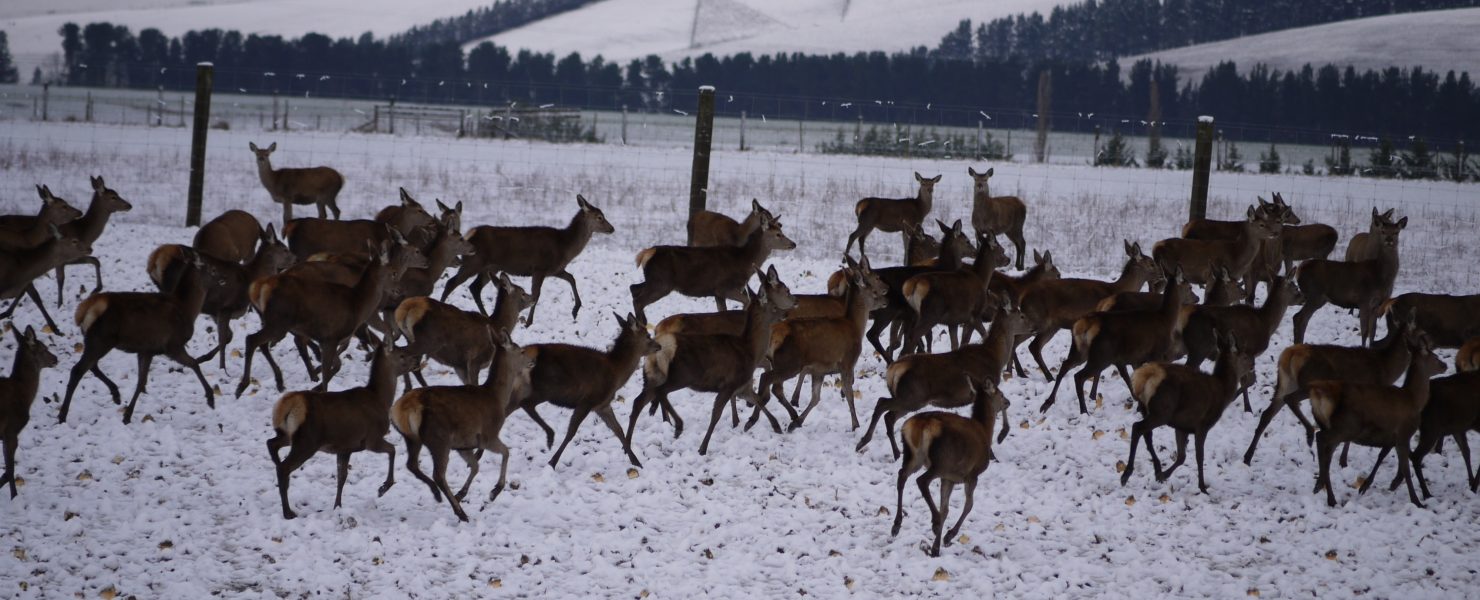
Hopefully, the weaning process has gone smoothly this year and, despite the recent dry conditions in many regions, with careful planning and feed management, you have still achieved some decent autumn growth rates in the fawns. As the day length has now decreased into winter, the growth potential of weaners has also decreased, so realistically we cannot think about playing catch-up for those that are behind until the daylight hours increase again in August. Larger weaners are more efficient at utilising winter feed due to their lower heat loss, and they may keep moving forward if well grown already, and this provides us with good incentive for smooth weaning and autumn practices.
Depending on multiple factors, such as genetics, pasture allowance, grazing residuals and the weight of weaners going into the winter, growth rates through winter will range from 40-120g/day for reds and up to 150g/day for elk crossbreds. To achieve these higher rates, feed allowance and quality (ME) must be very high and, if the farm is not set up appropriately well in advance, this may come at the cost of other stock.
Each of your farms will be different with what you can achieve this winter, and it may be that, due to the dry, you are now just looking to maintain the weaners and prioritise feed for August onwards (when you can achieve better utilisation and feed efficiency). It is important however that animals are not allowed to go backwards, as turning them around again into a positive growth curve will involve high feed costs.
With this in mind, it is likely that a lot of you are utilising crops such as kale, swedes or fodder beet, which mean the production of high volumes of maintenance feed from a small area. Therefore, spelling pasture for the spring flush, when consistent high growth rates can be achieved once the pasture quality allows for it, is important. These gains are usually consistent enough (at 260-320g/day) that you can then predict slaughter weights and dates according to the weights achieved at the end of autumn and winter.
Winter crops should be fed on a long narrow face to maximise access, reduce wastage and help comply with your environmental regulations. Supplements should be fed alongside crops, to provide fibre and possibly an additional protein source. The supplement types and amounts necessary will depend largely on your crop, so it is important to have your feeds tested to establish their protein content, DM yield and possible nitrate risk.
Then you can supplement accordingly and prevent spending money on expensive supplements that may not be justified. By weighing your weaners, it will help you calculate your feed requirements and ensure that the daily allowance is appropriate. During inclement weather, these allowances will need to be increased to allow for wastage and increased maintenance requirements.
The animals’ intakes will naturally increase in late winter with increased daylight, so their daily allowance may need to be increased accordingly, thus enabling you to take advantage of their potential to grow when this shift occurs. If you find that their appetite has instead ‘tired’ late in the season, it may be that they have lost interest in that crop, and, if you have one available, a swap on to another crop may protect against this. For this reason you may find it useful to have mobs on different crops simultaneously and allow for a swap mid-winter.
Try to avoid crops in paddocks that are prone to collecting surface water, as this will increase the risk of leptospirosis and feet issues such as Fusobacteriosis. You are encouraged to make post-mortems a regular practice on farm, allowing you to identify the cause of deaths, and, with discussion with your veterinarian, further testing can be implemented and an appropriate plan be put in place to minimise any losses through the winter.
Often deaths are given an assumed cause and can be over-represented as yersiniosis or Fuso. With the change in climate, we are seeing different pasture growth patterns and therefore diseases ‘out-of-season’. Conditions such as clostridial disease, laminitis, lepto or thiamine B1 deficiency are being seen on properties where they have not previously been experienced.
Parasite distribution and seasonal patterns are changing too and in general are extending into the winter months. Thankfully, with the recent talk of increased drench resistance in sheep (and more recently in cattle) the deer farmers are also picking up on this and asking appropriate questions. There is no new or ‘novel’ drench available to the deer industry, so it is vital that the triple drench Cervidae is protected for as long as possible. So all of the Wormwise principles need to be applied to deer farms as well, i.e. cross species grazing, higher grazing residuals, providing refugia (usually in the form of undrenched adult deer), high protein specialist diets, targeted drenching and, MOST importantly, minimising exposure to larvae.
In this way we are aiming to decrease the need to drench as often, thus taking the pressure off the limited drenches available to us. Every farm will be different and it is important to create an integrated parasite management plan specific to your property and the season you are facing. Faecal egg counts cannot be relied on even at this age, so planning and monitoring of LWGs, scouring and coughing are vital, especially if still grazing grass-based pasture rather than fodder crops through the winter.
The key to young deer success is minimising stress and maintaining nutrition. Depending on your risk profile, this includes appropriate trace element supplementation for copper plus selenium, parasite control, and vaccination for yersinia, leptospirosis and clostridia. Using ‘Auntie’ hinds within the mobs may help you with movement through paddocks and sheds and also feed transitions, and these girls should offer an overall calming effect, the benefits of which should not be underestimated.
For specific animal health and nutrition information, including feeding fodder crops and working with the seasons, visit the deernz.org/deer-hub.